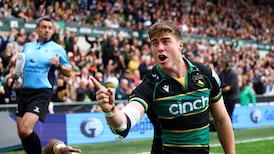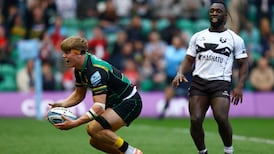All Black teenager, dead at 40, Jonah Lomu did plenty of living in between.
Johannesburg May 27th, 1995 is where and when rugby gets divided into two distinct eras: Before Lomu and After Lomu. Ireland played a grim supporting role, green clad heroes appearing like boys unable to slow one man when in actual fact it was the other way around.
Lomu’s first imprint remains a seminal moment because it symbolises the crossover from amateur hour to professionalism.
Ireland were the first but not the last of the sacrificial lambs. Lomu performances between 1995 and 2002 can never be replicated. Nor can his impact be over exaggerated. Mike Catt’s great grandchildren will be fielding questions about that attempted tackle.
The Offload: Women’s rugby in Ireland needs protecting more than ever
The Best of Times: Ireland’s Golden Generation make Grand Slam history in 2009
Rugby impasse continues as no deal reached in fourth round of IRFU salary talks
Matt Williams: Six Nations must recognise the desire for revolution outside Europe
Lomu was the cheat in a computer game. Cartoonish invincibility that transcended rugby, creating unforgettable reality TV as he ruptured defences with naked violence.
He made skinny wingers an endangered species. Richard Wallace was informed in the hotel lobby, days before the game, that a six foot five inch, 18 stone kid who runs 100 metres in 10.7 seconds was coming for him.
He had done no research: “The bigger they are the harder they fall – I didn’t realise he was going to be falling on top of me.”
What was so intimidating about Lomu was how he sought opponents out. Not a bully bone in his body, he’d prey on the strong as much as the weak. There was no escape once locked by those bulging eyeballs during the haka.
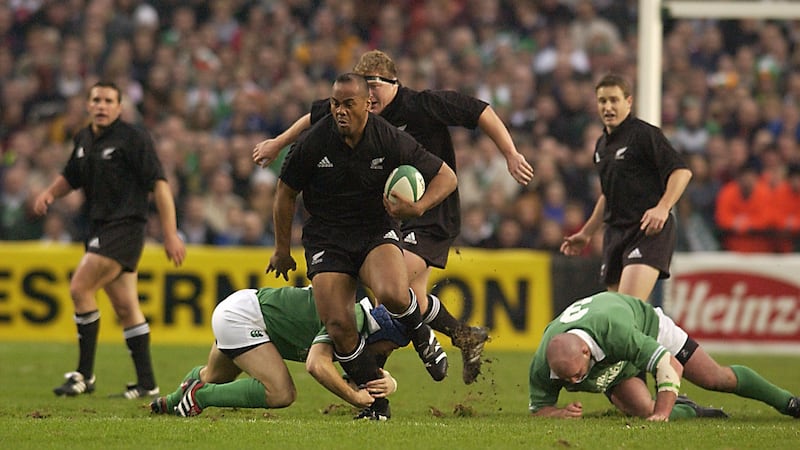
Raw Tongan muscle harnessed at the famed Wesley College – where he managed to avoid Auckland's gang culture – but equally nurtured on the Sevens circuit by his old pal Eric Rush, Lomu was rapidly indoctrinated into the All Blacks religion.
Capped at 19, dead at 40, he suffered far more pain than the jaw dropping damage he meted out.
In the beginning a temporarily insane Irish prop decided to poke the bear. Gary Halpin gets most of the blame for flipping both birds at the entire black line having crashed over for an early score, but it is Michael Bradley who gifted the frightened boy with his first international try.
“It was the most nerve-racking time I have ever had in my life,” remembered Lomu years later. “Let’s get this game on because the nerves will kill me soon – I know the game won’t – but the throwing up will.”
Fly hacking the ball inches from your own line is a cardinal sin in underage rugby. You dive on the leather or go play round ball.
Lomu: “I couldn’t believe the first try because a guy kicked it straight into my hands.”
A lifetime felling bigger little brothers couldn’t prepare Wallace for the full impact.
“There was a 15-metre blindside,” he said in No Borders. “There was me and there was him.”
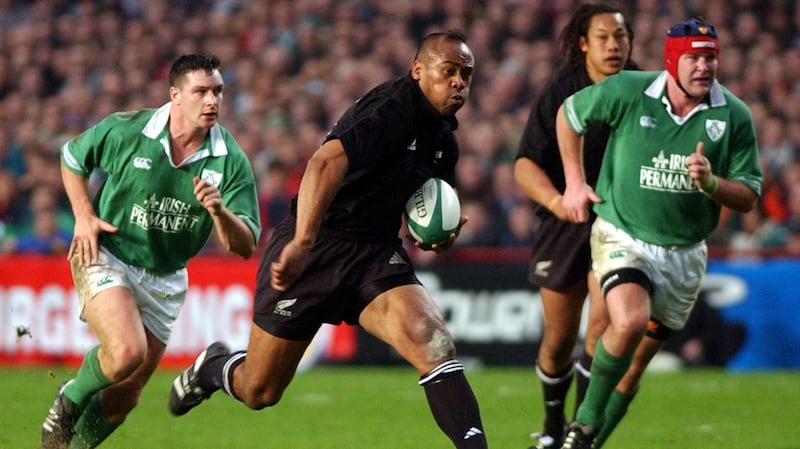
Brendan Mullin was unable to lend much of a hand but he put apt words around the scene: "It was obvious this was a pretty significant night in the history of rugby because he was a phenomenal individual."
Simon Geoghegan was a mean tackler. A lone star in this miserable decade for Ireland, Geoghegan instinctively understood something lost on so many; to fell Lomu you go low, get your head behind that giant calf and squeeze like a python.
Maurice Field went a fraction higher, just below the hips, and ended up staring at the moon. Geoghegan's tackle came at the end of the most stunning moment in the history of televised rugby as a nimble offload allowed Josh Kronfeld to fall over the whitewash, the rout complete.
Adoption of Rugby League defensive techniques are directly traced back to the havoc Lomu caused in Ellis Park.
Never has one man dominated one rugby tournament so completely that the purest of singular sporting nations took to shovelling, bouncing, rolling ball to the left wing.
Lomu was the big boned boy in the school yard elevated onto the world stage. The sport needed to rapidly evolve around him.
Fellow islanders, massive French ogres, arrogant English and Aussies all stood in his path to little avail. South Africans took to drugging him before wrapping his body in chains and dumping it in an icy river. Wait, no, sorry, that was Rasputin.
Lomu was a comet that burnt across the sky. That three of the four wingers who started the 1995 World Cup final have died young is another story worth pursuing, if omertà permits.
In 1995 we bore witness to a game-changing event that resonates to this day. Rugby had what all pro sport eventually needs – a mighty marketing weapon.
Ireland was his third cap. He had two tries before the comic-book charge sparked the imagination of Obelix, He-Man and Road Runner all rolled into one eye rubbing vision.
Meep Meep. Geoghegan did a decent impression of Wile E Coyote.
Pause and rewind to the moment that changed rugby forever: Ireland on the attack until Terry Kingston's one hand lineout floater is picked off by Ian Jones, prompting New Zealand to attack from their 22 with a cut-out pass by Walter Little unleashing those gigantic thighs, scattering four green jerseys; each making textbook tackles that proved the syllabus required instant overhaul.
If Irish resistance appeared child-like, England were to suffer a far deeper humiliation come the semi-final.
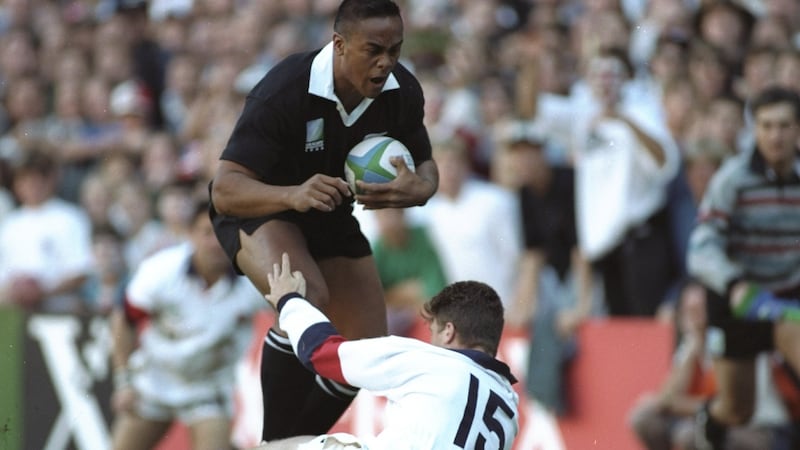
“I can still hear his footsteps in my mind. Feel the ground start to shake and my pulse quicken.” Catt’s ghost writer did a fine job. “I first felt his left knee, knocking me backwards off my feet. Next came his right and I went from my backside on to my back with the force of the collision. I grasp for something to hold on to, my arms flailing. But he was over the top of me, those three-trunk legs pumping like pistons. And then it was over. He hadn’t fallen at all. In fact he had regained his balance. Three more strides and he dived across the try-line . . . I lay sprawled in the Newlands turf, shell-shocked.”
The Springboks managed to slow a food-poisoned Lomu in the final but when the dust settled on the iconic moment between Francois Pienaar and Nelson Mandela, rugby had its first megastar.
On July 9th, 1995 the New Zealand rugby union put a registered trademark on his name. This meant they possessed commercial authority over the use of “Jonah Lomu”.
"He's the one that will take rugby worldwide," said Michael Lynagh.
This did happen but a sport that is still governed along colonial lines was ill-equipped to follow Lomu into every corner of the planet 25 years ago. This friendly giant trampled a path for Pacific Island families to escape poverty. That their talent has been manipulated to the extent we have seen ever since is to rugby’s great and eternal shame.
Clearly, the game still needs him but tragedy intervened. Lomu’s career came to a grinding halt as the narrative shifted to his health. He was just as devastating at the 1999 tournament, bringing his try tally to 15 – a record only equalled by Bryan Habana – but the 2003 World Cup escaped him due to the illness that led to a kidney transplant in 2004.
He had a parting gift for Ireland. People present at Lansdowne Road in 2001 were warmed by the embers of an incomparable Test career.
Jonah Lomu died suddenly on November 18th, 2015 of a heart attack associated with his condition, nephritis.
“It will be another hundred years before we see another one like him,” said Rush.
That’s being generous as transcendental talent follows no pattern. How can the game be altered, be so utterly dominated by one physical specimen now that every team has a Jonah Lomu replica in their squad?
The loss of his massive personality, snatched away from his young family and the world, was evident at the funeral. Buck Shelford led a haka of past and present All Blacks as the coffin slow marched into an empty Eden Park. Nobody in New Zealand had been afforded such a reverent farewell.
Words encapsulate him as much as Richard Wallace or Mike Catt ever could. Seeing was the only way to believe Lomu was real.








